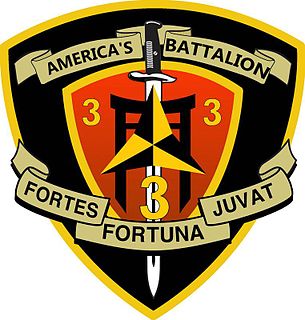 W
W3rd Battalion, 3rd Marines, abbreviated as (3/3), is an infantry battalion of the United States Marine Corps, based out of Kāne'ohe, Hawai'i. Known as either "Trinity" or "America's Battalion", the unit falls under the command of the 3rd Marine Regiment of the 3rd Marine Division. The unit consists of approximately 1124 U.S. Marines and United States Navy sailors.
 W
WThe 2003 invasion of Iraq was the first stage of the Iraq War. The invasion phase began on 19 March 2003 (air) and 20 March 2003 (ground) and lasted just over one month, including 26 days of major combat operations, in which a combined force of troops from the United States, the United Kingdom, Australia and Poland invaded Iraq. This early stage of the war formally ended on 1 May 2003 when U.S. President George W. Bush declared the "end of major combat operations", after which the Coalition Provisional Authority (CPA) was established as the first of several successive transitional governments leading up to the first Iraqi parliamentary election in January 2005. U.S. military forces later remained in Iraq until the withdrawal in 2011.
 W
WThe 2005 Al-Anbar CH-53E crash refers to an aviation accident which occurred on January 26, 2005 when a United States Marine Corps CH-53E Super Stallion helicopter crashed while ferrying U.S. military personnel in the Al-Anbar province of western Iraq, near the town of Ar-Rutbah. All thirty-one troops aboard the helicopter died in the crash which made it the deadliest single incident for U.S. troops during the Iraq War. The accident took place while coalition forces were trying to secure the country ahead of the January 2005 Iraqi parliamentary election slated to take place later that month. The cause of the crash was determined to be the pilots becoming disoriented when they flew into a sandstorm
 W
WThe Battle of Abu Ghraib was a battle between Iraqi insurgents and United States forces at Abu Ghraib prison on April 2, 2005.
 W
WThe Anbar campaign consisted of fighting between the United States military, together with Iraqi Government forces, and Sunni insurgents in the western Iraqi governorate of Al Anbar. The Iraq War lasted from 2003 to 2011, but the majority of the fighting and counterinsurgency campaign in Anbar took place between April 2004 and September 2007. Although the fighting initially featured heavy urban warfare primarily between insurgents and U.S. Marines, insurgents in later years focused on ambushing the American and Iraqi security forces with improvised explosive devices (IED's), large scale attacks on combat outposts, and car bombings. Almost 9,000 Iraqis and 1,335 Americans were killed in the campaign, many in the Euphrates River Valley and the Sunni Triangle around the cities of Fallujah and Ramadi.
 W
WAyn al Asad is an Iraqi Armed Forces and United States Armed Forces base located in Al Anbar Governorate of western Iraq. The base is also used by British Armed Forces in Iraq. It was originally known as Qadisiyah Airbase.
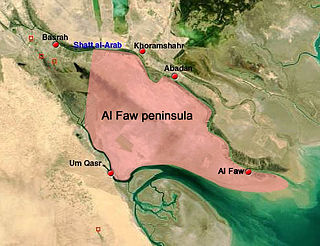 W
WThe Battle of Al Faw was one of the first battles of the Iraq War; it took place March 20-24, 2003.
 W
WThe Battle of Al-Qa'im was a military offensive conducted by the United States Marine Corps, against insurgent positions in Iraq's northwestern Anbar province, which ran from 8 May 2005 to 19 May 2005. It was focused on eliminating insurgents and foreign fighters in a region known as a smuggling route and a sanctuary for foreign fighters.
 W
WOperation Alljah was an operation launched by Coalition forces in Iraq, mainly U.S. Marines, in June 2007 to secure the neighborhoods of Fallujah. The strategy of the operation was somewhat based on a successful operation in Ramadi conducted in 2006. Insurgents in the town of Karma nearby were also targeted during the operation, which was part of the overall operation Phantom Thunder.
 W
WThe Battle of Baghdad, also known as the Fall of Baghdad, was a military invasion of Baghdad that took place in early April 2003, as part of the invasion of Iraq.
 W
WCamp Baharia, also known as Dreamland or FOB Volturno, was a U.S. military installation that was just outside the city of Fallujah, Iraq. It was the smaller of two major U.S. military bases maintained just outside the Fallujah city limits, during the Iraq War.
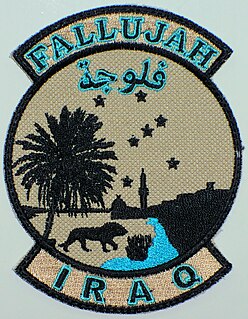 W
WCamp Fallujah is a large compound in Fallujah, Iraq used by the U.S. Marines from 2004 to 2009.
 W
WThe First Battle of Fallujah, code-named Operation Vigilant Resolve, was an operation against militants in Fallujah as well as an attempt to apprehend or kill the perpetrators of the killing of four U.S. contractors in March 2004.
 W
WThe Second Battle of Fallujah—code-named Operation Al-Fajr and Operation Phantom Fury—was a joint American, Iraqi-government, and British offensive in November and December 2004, the highest point of conflict during the Iraq War. It was led by the U.S. Marines against the Iraqi insurgents in the city of Fallujah, and was authorized by the U.S.-appointed Iraqi Interim Government. The U.S. military called it "some of the heaviest urban combat U.S. Marines have been involved in since the Battle of Huế City in Vietnam in 1968."
 W
WFirdos Square is a public open space in central Baghdad, Iraq. It is named after the Persian word Firdows, which means "paradise". The site has been the location of several monumental artworks.
 W
WForward Operating Base Kalsu, also known as 'FOB Kalsu', COS Kalsu or simply Camp Kalsu, was a U.S. Military installation in Iskandariya, Iraq, 20 miles south of Baghdad. It was officially closed by members of the 1st Brigade Combat Team, 1st Cavalry Division, on December 12, 2011 as part of the US Army's withdrawal from Iraq.
 W
WForward Operating Base Loyalty is a former forward operating base used by the U.S. Army during Operation Iraqi Freedom and Operation New Dawn located in the New Baghdad District of Baghdad, Iraq.
 W
WOperation Guardian Tiger IV was an operation conducted by Marines from the 3rd Battalion, 3rd Marine Regiment and Iraqi Police in the Haditha Triad area in 2006. The operation was focused on conducting a census in the Baghdadi area with the goal of capturing terrorists and building up local police forces. Only a handful of Marines accompanied the Iraqis.
 W
WThe Battle of Haditha was a battle fought between U.S. forces and Ansar al-Sunna in early August 2005 on the outskirts of the town of Haditha, Iraq, which was one of the many towns that were under insurgent control in the Euphrates River valley during 2005.
 W
WThe Haditha massacre was a series of killings on November 19, 2005, in which a group of United States Marines killed 24 unarmed Iraqi civilians. The killings occurred in Haditha, a city in Iraq's western province of Al Anbar. Among the dead were men, women, elderly people and children as young as 1, who were shot multiple times at close range while unarmed. It was alleged that the killings were a response to the attack on a convoy of Marines with an improvised explosive device that killed Lance Corporal Miguel Terrazas.
 W
WThe Battle of Al Hillah was an armed military confrontation between military elements of the United States and Iraq during the 2003 Invasion of Iraq. Prior to the Iraq War, the ancient city of Al Hillah was home to numerous bases for the Iraqi Medina division of the Iraqi Republican Guard. As a main objective of the invasion of Iraq was to disable the Republican Guard, this made Al Hillah an important target for Coalition forces, as well as the fact that Al Hillah lay in the path of the planned Coalition advance Najaf.
 W
WThe Iraq spring fighting of 2004 was a series of operational offensives and various major engagements during the Iraq War. It was a turning point in the war: before, the conflict was simply US/Coalition versus insurgents, but the Spring Fighting marked the entrance of militias and religiously based militant Iraqi groups, such as the Mahdi Army into the arena of conflict.
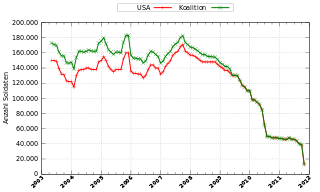 W
WIn the context of the Iraq War, the surge refers to United States President George W. Bush's 2007 increase in the number of American troops in order to provide security to Baghdad and Al Anbar Governorate.
 W
WLex was the first active duty, fully fit military working dog to be granted early retirement in order to be adopted. Working for his United States Marine Corps handler Corporal Dustin J. Lee in the Iraq War, he was wounded in an attack that killed Lee, and subsequently awarded an honorary Purple Heart.
 W
WLucca was a German Shepherd/Belgian Malinois service dog who was employed by the United States Marine Corps for 6 years. She was trained to detect explosives. She was deployed twice to Iraq and once to Afghanistan. In her over 400 missions, no human fatalities occurred under her watch. In 2012, while on patrol in Afghanistan, she was injured by an IED blast, necessitating the amputation of her left leg. After recovering at Camp Pendleton, Lucca officially retired in 2012 and was adopted by her original handler, Gunnery Sergeant Chris Willingham.
 W
WOperation Al Majid was an operation conducted by both Marines and Iraqi security forces intended to disrupt and defeat insurgent activity throughout more than 30,000 square miles (78,000 km2) in western Al Anbar Province. The operation began in the fall of 2006 and resulted in a series of berms being constructed around the cities of Anah, Haditha, Haqlaniyah, and Barwanah.
 W
WOperation Mawtini was launched on 15 July 2007 by the Regimental Combat Team 2, located in western Al Anbar province, to neutralize attempts by anti-Iraqi Forces to re-establish a presence in key urban areas along the Euphrates River valley.
 W
WThe Multi-National Force – Iraq (MNF–I), often referred to as the coalition forces, was a military command during the 2003 invasion of Iraq and much of the ensuing Iraq War, led by the United States of America, United Kingdom, Australia, Spain and Poland, responsible for conducting and handling military operations.
 W
WMulti-National Forces West (MNF-W) or United States Forces West (USF-W) was one of the coalition headquarters under Multi-National Force-Iraq. It was headquartered by either I or II U.S. Marine Expeditionary Force that rotated on a 12-month basis. Their area of operations was primarily the Al Anbar province which includes the cities of Ar Ramadi, Fallujah, Al-Qa'im, and Haditha. The force was the most important U.S. unit to take part in the Iraq War in Al Anbar Governorate.
 W
WThe Battle of Najaf was fought between United States and Iraqi forces on one side and the Islamist Mahdi Army of Muqtada al-Sadr on the other in the Iraqi city of Najaf in August 2004.
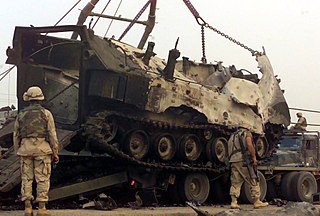 W
WThe Battle of Nasiriyah was fought between the US 2nd Marine Expeditionary Brigade and Iraqi forces from 23 March to 2 April 2003 during the US-led invasion of Iraq. Nasiriyah is a city which lies along the banks of the Euphrates River in Dhi Qar Province, about 225 mi (362 km) southeast of Baghdad. Its population is made up almost entirely of Shia Muslims. On the night of 24–25 March, the bulk of the Marines of Regimental Combat Team 1 passed through the city over the bridges and attacked north towards Baghdad. However fighting continued in the city until 1 April when Iraqi resistance in the city was defeated.
 W
WAfter the handover of sovereignty, Operation New Market was a sweep of an area near Haditha in western Iraq conducted by one thousand coalition and Iraqi Security Forces to rid the Euphrates river bank of anti-coalition forces. It was launched on 24 May 2005 and followed Operation Squeeze Play. New Market was followed by Operation Lightning. The operation was named after the famous US Civil War battle at New Market, VA where cadets from the Virginia Military Institute fought and some perished.
 W
WOperation Phantom Thunder began on 16 June 2007, when Multi-National Force-Iraq launched major offensive operations against al-Qaeda and other extremist terrorists operating throughout Iraq. Operation Phantom Thunder was a corps level operation, including Operation Arrowhead Ripper in Diyala Province, Operation Marne Torch and Operation Commando Eagle in Babil Province, Operation Fardh al-Qanoon in Baghdad, Operation Alljah in Anbar Province, and continuing special forces actions against the Mahdi Army in southern Iraq and against Al-Qaeda leadership throughout the country. The operation was one of the biggest military operations in Iraq since the U.S. invasion in 2003.
 W
WThe Battle of Ramadi was fought during the Iraq War from March 2006 to November 2006, for control of the capital of the Al Anbar Governorate in western Iraq. A combined force of U.S. Army Soldiers, U.S. Marines, U.S. Navy SEALs, and Iraqi Security Forces fought insurgents for control of key locations in Ramadi, including the Government Centre which was held by 1st Bn 6th Marines bravo company and the General Hospital. Coalition strategy relied on establishing a number of patrol bases called Combat Operation Posts throughout the city, many of which were manned by elements of 1st Bn 6th Marines and some from the Army on the outer parts of the city.
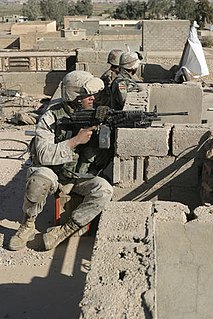 W
WOperation Sayeed also known as Operation Hunter in English, was a series of operations conducted in western Al Anbar Governorate by the United States Marine Corps in 2005. It was an umbrella operation, consisting of at least 11 named operations between July 2005 to December 2005. The purpose was to drive Al-Qaeda in Iraq forces from the Western Euphrates River Valley. Some parts of Operation Sayeed were Operation Steel Curtain and Operation Iron Fist.
 W
WThe Second Battle of Habbaniyah was a U.S. military operation involving in Iraq the United States Marine Corps' 3rd Battalion, 2nd Marine Regiment, 2nd Marine Division, operating under the command of Regimental Combat Team 5. The battle took place between August 17, 2006 and February 14, 2007.
 W
WOperation Steel Curtain was a military operation executed by coalition forces in early November 2005 to reduce the flow of foreign insurgents crossing the border and joining the Iraqi insurgency. The operation was important in that it was the first large scale deployment of the New Iraqi Army. This offensive was part of the larger Operation Sayeed (Hunter), designed to prevent al Qaeda in Iraq from operating in the Euphrates River Valley and throughout Al Anbar and to establish a permanent Iraqi Army presence in the Al Qa’im region.
 W
WAl Taqaddum Airbase, or Al Taqaddum AB, , is an air base that is located in central Iraq, approximately 74 kilometers west of Baghdad, at Habbaniyah. The airfield is served by two runways 13,000 and 12,000 feet (3,700 m) long. Since 2004, it has been known as Camp Taqaddum. It was formerly known as Tammuz Airbase.
 W
WTask Force Tarawa (TFT) was the name given to the 2nd Marine Expeditionary Brigade during the 2003 invasion of Iraq. It was a Marine Air-Ground Task Force commanded by Brigadier General Richard F. Natonski that was attached to the I Marine Expeditionary Force during the course of the invasion and was most notable for its participation in the heavy fighting in the city of an-Nāṣiriyyah. During its time supporting Operation Iraqi Freedom, the task force suffered 23 Marines killed in action.
 W
WThe Battle of Umm Qasr was the first military confrontation in the Iraq War. At the start of the war, one of the first objectives was the port of Umm Qasr. On 21 March 2003, as allied forces advanced across Southern Iraq, an amphibious landing force captured the new port area of Umm Qasr. The assault was spearheaded by Royal Marines of the British 3 Commando Brigade, augmented by U.S. Marines of the American 15th MEU and Polish JW GROM troops. Iraqi forces in the old town of Umm Qasr put up unexpectedly strong resistance, requiring several days' fighting before the area was cleared of defenders. The port was finally declared safe and reopened on 25 March 2003.